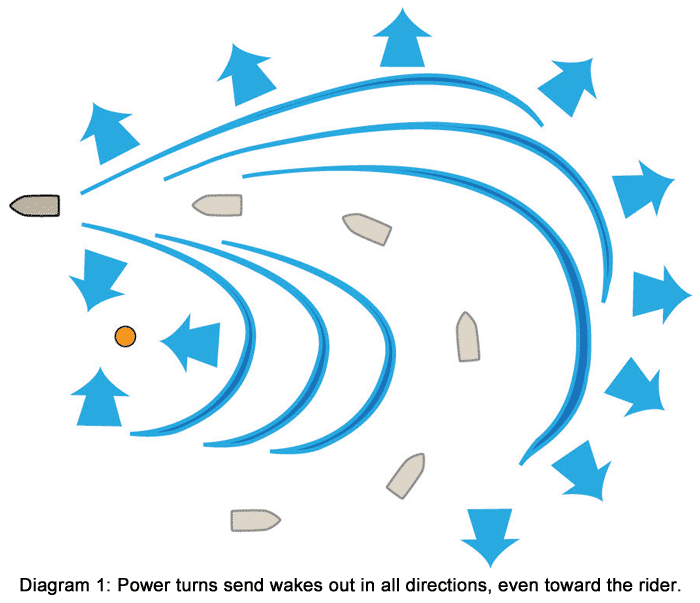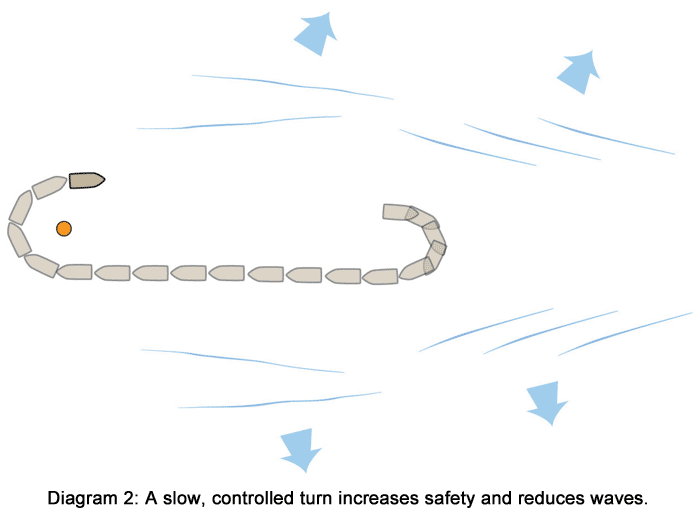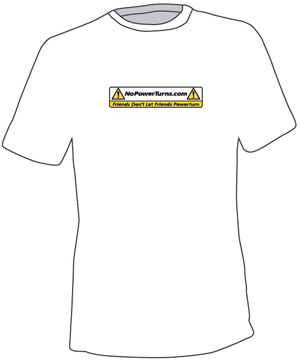
A friendly public service announcement to improve everyone's on-water experience!
What exactly is a power turn?
Any time a boat makes a turn at cruising speed, it's called a power turn. Although there are circumstances where a power turn might be necessary, 99% of the power turns you see out on the water are not. Instead, they are dangerous, waste fuel and produce wakes that unnecessarily churn up the water as seen in Diagram 1.

Why are power turns dangerous?
Turning any vehicle at a high rate of speed has the potential to throw passengers and gear around within the vehicle or even toss them out of the vehicle. When you're dealing with a boat, this danger is even greater because passengers are not strapped in with seatbelts and are not usually given any warning when a power turn is initiated.
Power turns are also dangerous for other boaters and riders (wakeboarders, waterskiers, tubers, etc.) that may be sharing the water. When a power turn is initiated, it makes it more difficult for the boat driver to see any boats, PWC's and/or riders that may be sharing the water nearby. By performing this maneuver at a high rate of speed, the odds of colliding with another boat, rider or even the shore are increased greatly.
The unnecessary wakes sent across the water by a power turn present another danger to other boaters and/or riders sharing the water. The added waves make the entire body of water more unpredictable and rough. You might also end up swamping your rider if you send wakes in his or her direction.
How do power turns waste fuel?
This one is a no brainer. To keep up a boat's speed when power turning, it's necessary to give the throttle more gas. Compare that to simply pulling back on the throttle and idling around once the boat slows down, and you'll find a lot less fuel dumping into your engine.
How do power turns effect other boaters and riders?
The wakes generated by a standard power turn travel outward approximately 270 degrees from the boat (see Diagram 1 above). These waves will continue until they hit the shore even if that means they have to travel across the entire lake. Every time a power turn is initiated, it adds to the general roughness of the water making wakeboarding and waterskiing more difficult and unpleasant for all, including the boater that created them! A lake full of boaters that work to eliminate the number of waves they generate will provide a much better day for all than a lake full of power turners.
What's the alternative to power turning?
When you go to pick up your rider, start by pulling the throttle to the idle position before initiating the turn. Once the boat has slowed down to a speed where there is no wake, idle around the turn. It's often a good idea to wait for the boat's wakes to pass by before initiating the turn. Otherwise, you'll be idling through your own wakes. Then idle back to the rider and make your pickup. See Diagram 2 below.

 When are power turns acceptable?
When are power turns acceptable?
Although it's probably possible to get a citation if you're driving in a highly dangerous manner involving a power turn, power turns are not usually illegal on most bodies of water. In fact, there is the occasional situation in which a power turn might be advisable. If you have to return to your fallen rider quickly because they appear to be injured or in distress, a power turn may be the best way to get there quickly. You might also have a situation in which your rider appears to be in danger because of approaching boat traffic that would require you to get back to him or her quickly. In these situations, power turning is not only acceptable, but probably a good idea.
What can I do to help spread the word about power turns?
Obviously, the first step is to eliminate unnecessary power turns while you're on the water. Next, spread the word to your fellow boaters and riders and encourage them to do the same. If you anyone has any questions, send them to NoPowerTurns.com to find out everything they need to know about power turns. You can also purchase NoPowerTurns.com stickers, static-cling decals and tee-shirts in the WakeWorld Store.
The bottom line is that the responsible use of power turns by all boaters will increase safety
and sanity on the water. Please join us in spreading the word to your fellow boaters.


polhamus
quik876
quik876
lffish133
thescott
I suggest making the logo on the shirt BIGGER so people can read it easily.
baitkiller
jstenger
mattgettel
irony at its best
moneypit
I agree that power turns can be dangerous to others if no caution is taken by the boats operator. On an open lake that is not busy I seldom will do a hard power turn but I also will seldomly go to idle to get back to rider especially if they have hit hard. When turning my boats bows tend to remain flat so vision is not the issue and I will always check traffic around me before making any turn. To maximize my vision I will always turn to starboard when turning back.
I will power turn on Lakes that are busy as heck on weekends. I am going to get back to my rider ASAP and shield them from the nutcases who are watching their riders and not what is in front of them. Worse yet are the darn jetskis who will jump wakes from wakeboard boats after a rider has passed. Inboards are built to turn and track well. As long as the driver is cautious and his passengers are aware that a turn is coming it can be done safely to protect riders that have gone down.
The use of a Power turn has its purposes and can be executed safely depending on operators experience, traffic conditions and a host of other variables including what type of boat is being driven. Power turning with a ton of ballast is not wise so I won't do one with ballast.
Churning up the wake is not a concern when I need to protect my fallen rider.
olmoomba
twise
scott_nor_cal_syndicate
we all worry about our riders and yes we get back to them as quickly as possible the point is don't do it unless absolutely neccessary.
unclebill
Erik2393
wakerider111
devildog_ra
devildog_ra
devildog_ra
radrachel
blatantblunts